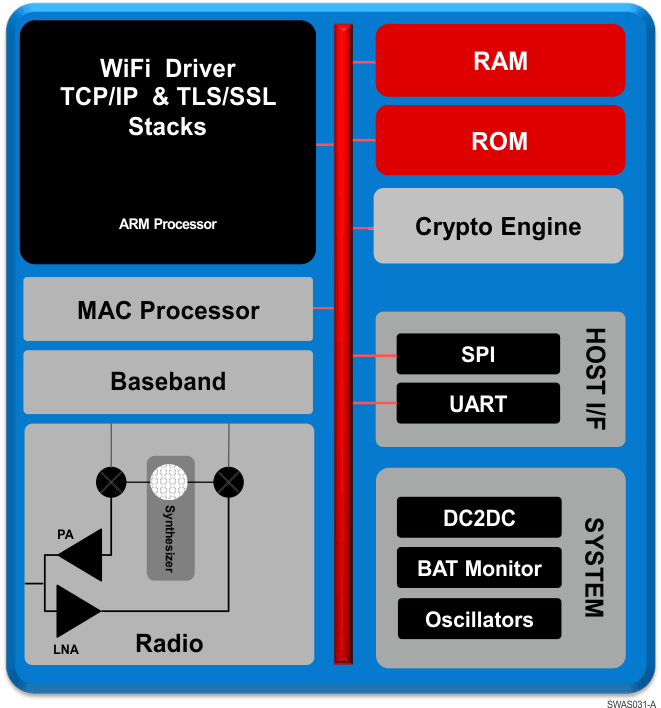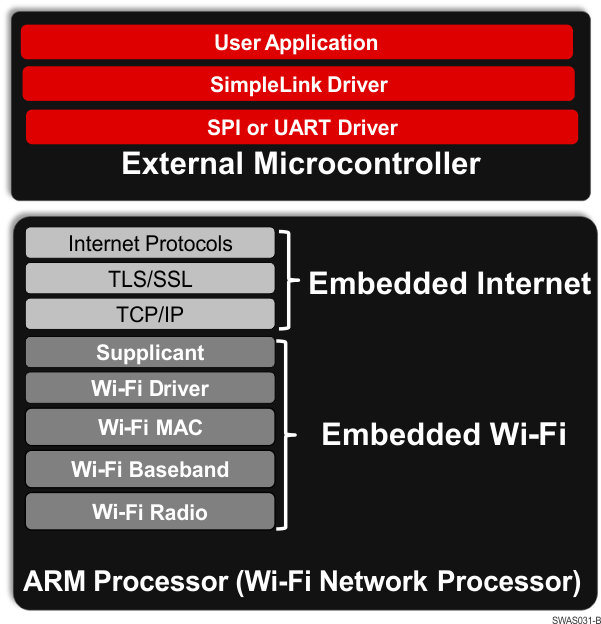SWAS031D June 2013 – February 2015 CC3100
PRODUCTION DATA.
- 1Device Overview
- 2Revision History
- 3Terminal Configuration and Functions
-
4Specifications
- 4.1 Absolute Maximum Ratings
- 4.2 Handling Ratings
- 4.3 Power-On Hours
- 4.4 Recommended Operating Conditions
- 4.5 Brown-Out and Black-Out
- 4.6 Electrical Characteristics (3.3 V, 25°C)
- 4.7 WLAN Receiver Characteristics
- 4.8 WLAN Transmitter Characteristics
- 4.9 Current Consumption
- 4.10 Thermal Characteristics for RGC Package
- 4.11 Timing and Switching Characteristics
- 4.12 External Interfaces
- 4.13 Host UART
- 5Detailed Description
- 6Applications and Implementation
- 7Device and Documentation Support
- 8Mechanical Packaging and Orderable Information
Package Options
Mechanical Data (Package|Pins)
- RGC|64
Thermal pad, mechanical data (Package|Pins)
- RGC|64
Orderable Information
1 Device Overview
1.1 Features
- CC3100 SimpleLink Wi-Fi Consists of Wi-Fi Network Processor and Power-Management Subsystems
- Wi-Fi CERTIFIED™ Chip
- Wi-Fi Network Processor Subsystem
- Featuring Wi-Fi Internet-On-a-Chip™
- Dedicated ARM MCU
- Wi-Fi Driver and Multiple Internet Protocols in ROM
- 802.11 b/g/n Radio, Baseband, and Medium Access Control (MAC), Wi-Fi Driver, and Supplicant
- TCP/IP Stack
- Industry-Standard BSD Socket Application Programming Interfaces (APIs)
- 8 Simultaneous TCP or UDP Sockets
- 2 Simultaneous TLS and SSL Sockets
- Powerful Crypto Engine for Fast, Secure Wi-Fi and Internet Connections with 256-Bit AES Encryption for TLS and SSL Connections
- Station, AP, and Wi-Fi Direct® Modes
- WPA2 Personal and Enterprise Security
- SimpleLink Connection Manager for Autonomous and Fast Wi-Fi Connections
- SmartConfig™ Technology, AP Mode, and WPS2 for Easy and Flexible Wi-Fi Provisioning
- TX Power
- 18.0 dBm @ 1 DSSS
- 14.5 dBm @ 54 OFDM
- RX Sensitivity
- –95.7 dBm @ 1 DSSS
- –74.0 dBm @ 54 OFDM
- Application Throughput
Completely Offloads Wi-Fi and Internet Protocols from the External Microcontroller
- Host Interface
- Interfaces with 8-, 16-, and 32-Bit MCU or ASICs Over SPI or UART Interface
- Low External Host Driver Footprint: Less Than 7KB of Code Memory and 700 B of RAM Memory Required for TCP Client Application
- Power-Management Subsystem
- Integrated DC-DC Supports a Wide Range of Supply Voltage:
- VBAT Wide-Voltage Mode: 2.1 to 3.6 V
- Preregulated 1.85-V Mode
- Advanced Low-Power Modes
- Hibernate with RTC: 4 µA
- Low-Power Deep Sleep (LPDS): 115 µA
- RX Traffic (MCU Active): 53 mA @ 54 OFDM
- TX Traffic (MCU Active): 223 mA @ 54 OFDM, Maximum Power
- Idle Connected: 690 µA @ DTIM = 1
- Integrated DC-DC Supports a Wide Range of Supply Voltage:
- Clock Source
- 40.0-MHz Crystal with Internal Oscillator
- 32.768-kHz Crystal or External RTC Clock
- Package and Operating Temperature
- 0.5-mm Pitch, 64-Pin, 9-mm × 9-mm QFN
- Ambient Temperature Range: –40°C to 85°C
1.2 Applications
- For Internet-of-Things applications, such as:
- Cloud Connectivity
- Home Automation
- Home Appliances
- Access Control
- Security Systems
- Smart Energy
- Internet Gateway
- Industrial Control
- Smart Plug and Metering
- Wireless Audio
- IP Network Sensor Nodes
1.3 Description
Connect any low-cost, low-power microcontroller (MCU) to the Internet of Things (IoT). The CC3100 device is the industry's first Wi-Fi CERTIFIED chip used in the wireless networking solution. The CC3100 device is part of the new SimpleLink Wi-Fi family that dramatically simplifies the implementation of Internet connectivity. The CC3100 device integrates all protocols for Wi-Fi and Internet, which greatly minimizes host MCU software requirements. With built-in security protocols, the CC3100 solution provides a robust and simple security experience. Additionally, the CC3100 device is a complete platform solution including various tools and software, sample applications, user and programming guides, reference designs and the TI E2E™ support community. The CC3100 device is available in an easy-to-layout QFN package.
The Wi-Fi network processor subsystem features a Wi-Fi Internet-on-a-Chip and contains an additional dedicated ARM MCU that completely offloads the host MCU. This subsystem includes an 802.11 b/g/n radio, baseband, and MAC with a powerful crypto engine for fast, secure Internet connections with 256-bit encryption. The CC3100 device supports Station, Access Point, and Wi-Fi Direct modes. The device also supports WPA2 personal and enterprise security and WPS 2.0. This subsystem includes embedded TCP/IP and TLS/SSL stacks, HTTP server, and multiple Internet protocols.
The power-management subsystem includes integrated DC-DC converters supporting a wide range of supply voltages. This subsystem enables low-power consumption modes, such as the hibernate with RTC mode requiringabout 4 μA of current.
The CC3100 device can connect to any 8, 16, or 32-bit MCU over the SPI or UART Interface. The device driver minimizes the host memory footprint requirements requiring less than 7KB of code memory and 700 B of RAM memory for a TCP client application.
Device Information(1)
| PART NUMBER | PACKAGE | BODY SIZE |
|---|---|---|
| CC3100R11MRGCR/T | QFN (64) | 9.0 mm x 9.0 mm |
1.4 Functional Block Diagram
Figure 1-1 shows the CC3100 hardware overview.
 Figure 1-1 CC3100 Hardware Overview
Figure 1-1 CC3100 Hardware Overview
Figure 1-2 shows an overview of the CC3100 embedded software.
 Figure 1-2 CC3100 Software Overview
Figure 1-2 CC3100 Software Overview